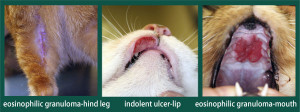Disease Spotlight: Feline Eosinophilic Granuloma Complex
EGC includes lesions (like these pictured above) that affect the skin, mucocutaneous junctions and oral cavity of cats. The term itself if often used as a final diagnosis, which in most cases in not appropriate because there is usually an underlying allergy as the primary cause.
What causes the immune system to react in this manner?
This is simply a way a cat shows it is having an allergic reaction to something: typically environmental allergens, food allergens, or insect bites (especially fleas or mosquitos). There may be a genetic factor also. In some cases we don’t know what causes the lesions and are thus said to be idiopathic.
- Granuloma: typically found on the outside of the hind limbs, face, or inside the mouth. Other presentations are puffy paw pads and “fat-chinned” cats. These patients are usually quite comfortable in their skin.
- Plaque: typically found on the inside of the hind limbs and on the belly. Secondary infection is common and pruritus is often severe.
- Indolent ulcer: looks like depressed ulcers of the upper lip margin(s). Pruritus & pain are rare.
How is the diagnosis made?
History, response to therapy and subsequent relapse rate can give clues as to the underlying cause of EGC. Patients may need a series of non-invasive core diagnostic tests and/or may ultimately need a skin biopsy to rule out other more serious conditions like skin cancer.
What can be done if my cat has this condition?
Some cats will respond to antibiotic therapy alone. Others need steroids or stronger immunosuppressive therapy. Most importantly, we also investigate and address underlying allergies as a way to use less medication over time.
Frequently Asked Questions
- My dog needs an allergy test but we are putting a steroid medication in the ears. Do I need to discontinue those meds? A recent study showed that a 7 day withdrawal of topical ear medications Mometamax® and Posatex® (containing the steroid mometasone), was sufficient for trustworthy intradermal allergy tests, as long as the pet has only received the topical ear medication for 14 days or less. Longer withdrawal periods should be considered if the pet has been on the topical medications long term.
- The results of my dog’s blood allergy test for food allergies say that my dog is allergic to every food ingredient, what should I feed my dog? Blood allergy tests for canine food allergies are available through many labs but their use is controversial. Numerous studies highlighting their shortcomings have been published over the past 20 years. Data from yet another study[i] was recently published to further challenge the credibility of these test results. As dermatologists, we do not recommend blood allergy testing for food allergy but rather recommend a strict hypoallergenic diet trial be performed using only a limited repertoire of prescription foods from trusted manufacturers.
- Which is better for pruritus, Atopica® or Apoquel®? The short answer: they are both equally effective. A recently published study[ii] showed that after 84 days of therapy, pruritus scores in the Atopica® group improved by 61.5% while dogs in the Apoquel® improved by 61%.
[i] Hardy et al. Food-specific serum IgE and IgG reactivity in dogs with and without skin disease: lack of correlation between laboratories. Vet Dermatol. 2014. 25(5):447-45
[ii] Little et al. A blinded, randomized controlled clinical trial comparing the efficacy and safety of oclacitinib and ciclosporin for the control of atopic dermatitis in client-owned dogs. Vet Dermatol. 2015. Feb;26(1):23-30
- Mar, 31, 2015
- Disease Spotlight


